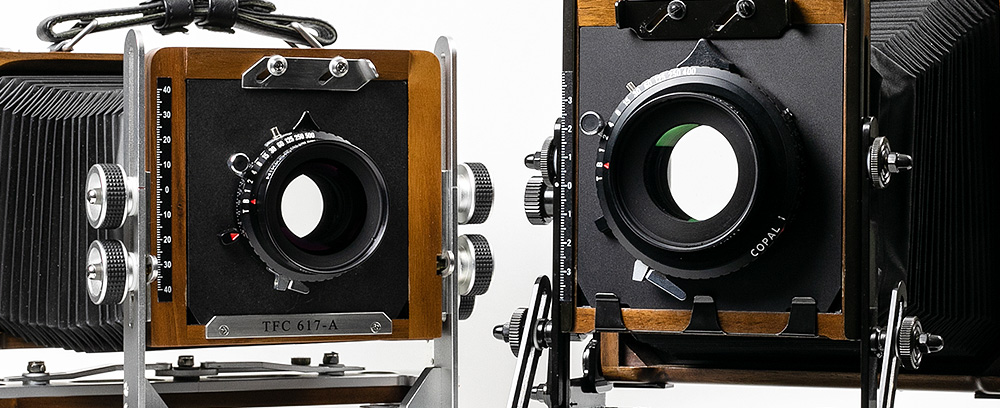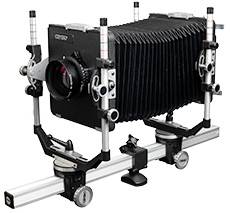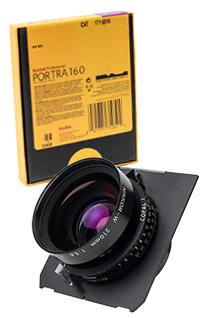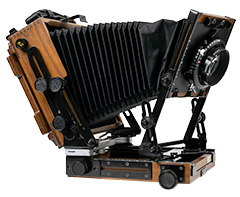Online Course for Large Format View Cameras
Large Format Photography


47 Video Lessons
self-paced online course
[?]
- 8.5+ Hours of Video Instruction
- 11 Field Demonstrations
- Unlimited Email Support
- Lifetime Course Access
- Satisfaction Guaranteed [?]
$300 Now $199
Add to Cart
"I’m working my way through the course and I’ve got to tell you
it’s even better than I could have hoped for."
- Martin | More Testimonials
Course Summary

Superior resolution, a slower pace of shooting, timeless camera designs that are easy to repair - there are no shortage of reasons to shoot large format film. But for me, the biggest attraction is the unrivaled versatility of a view camera. The amount of control it affords a photographer over the plane of focus, depth of field, perspective distortion, and composition are not only invaluable to a photographer's creative expression, they're just plain fun to use out in the field!
But let's be honest, large format photography can be intimidating, especially when it comes to applying seemingly-complex concepts like the Scheimpflug principle and lens tilts. Without proper training, a nice day out shooting large format can quickly turn to a disappointing evening at the light table. Few sorrows weigh heavier on a photographer's heart than a box of botched sheet film.
And that's why I've created this course.
When understood properly, even the most intimidating topics in large format photography are quite simple to apply with confidence, repeatability, and with excellent results. In this course I will take even the most novice large format photographer through the basics and into the most advanced topics of operating a view camera. You'll learn everything from focal length selection to focus plane manipulation by way of tilts and swings. You'll learn when to use rear tilt/swing vs front tilt/swing, how to determine the perfect spot to focus on, how to tell if your camera movements are actually helping, and much more!
Large format film ain't cheap! So don't waste frames experimenting and hoping you are doing things right. Take the first step towards becoming a master of large format photography today!
Online Photography Course Outline

- Section 1: Orientation
- To get you ready for the course, this section will cover some basics guidelines and advice to keep in mind as you progress through the lessons - pitfalls to watch out for, common mistakes to avoid, and how to get the most out of each section.
- Section 2: View Camera Basics & Equipment
- This section is designed to get you intimately familiar with all the parts and movements of a large format view camera so you can control and customize your camera with confidence. We'll cover:
- The purpose of rise, fall, shift, base tilts, axis tilts, and swings
- The 5 different view camera types on the market and what the pros and cons are to each
- The different components of a view camera including the ground glass, fresnel screen, bellows, standard film holders, roll film backs, polaroid backs, lens boards, shutters, and more
- Efficient techniques for loading and unloading film

- Section 3: Large Format Lenses
- A deep understanding of lens specifications, lens selection, and focal length is vital to your success in large format photography. That's why I have an entire section of this course devoted to lenses. In it you'll learn:
- How lens standard movements behave differently than rear standard movements
- How focal length affects perspective in your composition
- How to expertly choose your focal length to get the results you want
- What lens specifications like image circle, angle of coverage, and angle of view mean and what to pay attention to when analyzing these figures
- How aperture and depth of field change with large format photography
- Tips for working with wide angle lenses
- How to build the perfect lens kit
- Section 4: Rise, Fall, & Shift
- In this section we'll take a deep dive into the lateral movements of your view camera with rise, fall, and shift.
- We'll look at how to utilize these movements to fine tune composition, distort linear objects, and correct unwanted perspective distortion
- Includes 2 in-the-field demonstrations of how to apply these concepts in the real world
- We'll also look at the difference between moving the lens standard vs the rear standard when applying rise, fall, and shift
- Learn how to extend your camera's rise, fall, and shift limits

- Section 5: Focusing & Using Tilt/Swing
- The ability to alter the plane of focus with tilts and swings is one of the greatest advantages to using a view camera. It's also one of the most difficult aspects to understand in large format photography. That's why this is the most in-depth section of the course. In this series of lessons devoted to perfecting focus and depth of field, you'll learn:
- How to figure out exactly where to focus in any scene so as to maximize the effectiveness of your plane of focus and depth of field
- How to determine exactly what aperture to use to get the results you want
- What the Scheimpflug principle is and how it's used in large format photography to control focus
- What are the limitations of the Scheimpflug principle
- How to use both lens axis tilt and lens base tilt to control focus
- How to use rear tilt to alter distortion and focus
- How to use lens swing to control focus along the horizontal axis
- How to use rear swing to alter distortion and focus along the horizontal axis
- How to tell if your tilt/swing is actually helping
- How to tell if you need more tilt/swing
- Includes 6 in-the-field demonstrations!

- Section 6: Example Field Sessions
- In this final section of the course you'll see how these techniques are applied out in the field with 3 additional long-form field sessions.
Who's This Course For?

Intermediate Shooters
This course is marked for Intermediate shooters, but that really just means you aren't brand spankin' new to photography.
You don't need to be intermediate in your skills as a large format photographer, but you do need to be at least intermediate in your understanding of shutter speed, aperture, and ISO. I also strongly recommend you already be very confident in your light metering process (check out my Master Manual Metering for Film Photography course for help on that). Aside from that, this course can be easily digested by large format photographers of any skill level - including those brand new to large format photography.
If you've only ever shot smaller film formats, have never tried large format, or if you've never used a view camera before, that's no problem! This course will teach you all you need to know, starting with the basics. If you've already done a bit of large format photography or have studied it previously, this course may help fills some gaps in your knowledge. I encourage all prospective students to review the course outline above and check out the Free Preview page for a more extensive view of what the course will cover.
This course teaches you all the aspects you need to know to control your large format camera for predictable and successful results - from equipment basics to lens selection to tilt and swings with the Scheimpflug principle. This course does not, however, cover light metering, studio lighting or flash.
If you are interested in any of the following, then this course is for you:
- Understanding the intricacies of large format lenses and focal length selection
- Learning how to apply front and rear standard movements to control composition and distortion
- Learning how to apply tilts and swings efficiently and confidently to control focus and depth of field
- How to determine precise focus and aperture selection to achieve desired results
- Seeing how to operate a large format camera out in the field via live in-the-field demonstrations
- Demystifying the Scheimpflug principle for easy application
If you’re still unsure whether this course is right for you, email me at .
Requirements

Equipment Requirements:
If you already have a large format camera, great! Any brand camera will be fine for this course and it doesn't matter whether it's a monorail camera, folding camera, or a press camera - any view camera will work with the curriculum. If you haven't yet bought a large format camera, don't fret. You don't technically need to have a large format camera in hand before starting this course. In fact, one or more of the lessons may help you decide what camera to buy, so it might be best to watch the first few lessons before picking out a camera.
My large formats of choice on this course are 4x5 and 6x17, so you'll see example photos and field sessions with those two formats. I do, however, address other formats in the course and the topics covered in the lessons are equally applicable to any view camera, regardless of format. So if you are interested in any of the following film formats, this course is for you:
- 4x5
- 5x7
- 8x10
- 6x17
- 4x10
- Ultra-Large Formats
- Really any format that uses a view camera
Skill Requirements:
You do not need to have any previous training or experience in large format photography. So long as you already have a good handle on exposure basics and light metering, this course will cover everything else you need to know for successful large format photos.
What's Included

This online photography course is composed of:
- 47 Video Lessons
- Over 8.5 hours in all
- 11 in-the-field demonstrations (over 2.5 hours)
- Downloadable Worksheets
- Unlimited email support from Nick Carver
- Lifetime course access
This is a "work at your own pace" course, which means you can take the course at whatever pace works for your schedule. All lessons will be available to you from day 1 so you can study as fast or slow as you wish. To learn more about how the course works, visit this information page.
Throughout the course, you will have unlimited email support with a direct address to Nick Carver. Emails are typically answered within 2 business days depending on my volume of emails. Phone and/or online chat support is also available for an additional charge. Drop me a line for rates at .
47 Video Lessons
self-paced online course
[?]
- 8.5+ Hours of Video Instruction
- 11 Field Demonstrations
- Unlimited Email Support
- Lifetime Course Access
- Satisfaction Guaranteed [?]
$300 Now $199
Add to Cart






